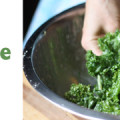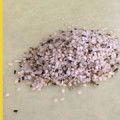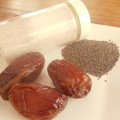
Are you by chance anything like me in that you love to discover a new food or flavor combination? (I think people refer to us as Foodies if I’m not mistaken) In those moments, everything else fades in the background and the only thing truly important is to have the experience of smelling it, touching it, tasting it and then thinking and talking about it…
It wasn’t unlike any other Wednesday a few weeks ago when I showed up at my favorite Farmer’s Market with my 3-year-old in tow. We sampled some local tamales, perused the vegetable bins for something interesting to cook for dinner that night and then made our way to a local baker. But then my little girl stopped me dead so she could get a closer look at something. It was a rather unassuming plate full of cute little blossoms with an orange hue. She was going crazy with curiosity and was deeply driven to pick one up. I was in Mom-mode so was set on telling her not to touch them but they were so attractive I was having a difficult time not pawing them myself! When I saw a young lady by the table, I kind of yelled a little bit at her saying “What are these?!!” She was very friendly (and hopefully appreciated my enthusiasm) and told us they were Pichuberries, considered to be the next high protein super fruit joining the ranks of acai and pomegranate. She then asked me if we wanted to sample one. She didn’t have to ask twice…

Origins and a Fruit with Many Names…
According to Mojo Tree Farm (more on them later), the Pichuberry is native to the highlands of Peru, Chile, Colombia, and other countries along the Andes Mountains. The original name of this fruit is the Incan berry. To many, the Pichuberry is known as the Lost Incan Crop. After being discovered, settlers began growing the Pichuberry in England. The English settlers then used the crop in their colonization of what is today South Africa. Around the year 1774, the Pichuberry was cultivated by early settlers at the Cape of Good Hope. In South Africa they are commercially cultivated and canned or sold in the form of jam. It is also cultivated and naturalized on a small scale in Gabon and other parts of Central Africa.
Is it Really Super Food?
The first thing you need to understand is that although it’s an extremely popular buzz word in the health industry (a Google search will get you 7,500,000 hits) there is no official scientific or otherwise legitimate definition of what makes a food super. Generally it’s a term given to foods that confer remarkable health benefits, is considered high in phytonutrients, has a long history in culture that speak to its medicinal benefits and grown in organic non-GMO crops. The final marker would then be to have it all proven in a lab so that it’s wrapped up in a neat little package deeming it SUPER.
Pichuberries do, in fact, seem to fit this definition to a certain extent. Here’s a brief overview of its nutrient breakdown and current research.
- High in Vitamin C, Thiamine, Niacin and B-12
- High in Zinc, Magnesium, Phosphorous and Potassium
- 1 cup of whole berries: 156 Calories, 4 grams of Protein, 34 grams of Carbohydrate, 0.0 grams of Fat and 7.2 grams of Fiber.
- Low Glycemic Index(impact a food has on blood sugar…can be an important factor in weight loss, diabetes and overall wellness…the lower the glycemic index is the better)
- Rich in Antioxidants
- Two scientific studies were conducted recently. One showed that the consumption of the berry extract inhibited the growth of human lung cancer cells and another study investigated the idea of it being a super food based on its mechanical, optical, chemical and nutritional properties. The conclusion of the author is that it fits this category based on the high level of phytosterols found in the oils extracted from the fruit which are known to lower blood cholesterol levels. It also was found to have anti-inflammatory, antimicrobial and anticancer properties making them substances of great interest for future research.
- Take a Look at the Nutrition Comparison with Pomegranate and Acai berries: http://www.pichuberry.com/pichuberry-general-info#!__pichuberry-general-info/health/vstc2=sup-f-com
 Delightful In Taste, Texture and Presentation
Delightful In Taste, Texture and Presentation
My daughter later described the berry as a Gift Fruit but she would probably agree with the French who call it Love in a Cage and rightly so. That’s because each berry (the size of a cherry tomato) is wrapped in three light yellow heart-shaped leaves that you must peel back. Then you can bite the berry right off the stem. The flavor is both sweet and tart and a little bit juicy but not like the pop of juice you get from a cherry tomato since it has more flesh and less seed. It’s a little confusing to the brain at first…am I tasting a fruit or a vegetable? The answer is yes.
This is a fruit that you could easily put on a platter or take to a picnic and have at it with no help whatsoever but Mojo Tree Farm also has some great recipes if you want to experiment; Elderflower, Pichuberry and Vodka Sorbet, Pichuberry Coffee Crepes and Pichuberry Salsa to name a few.
(Recipes: http://www.pichuberry.com/pichuberry-general-info#!__pichuberry-general-info/recipes/vstc1=pres)
 Where Can You Buy Them?
Where Can You Buy Them?
This where it gets interesting since you’re not going to find them in your neighborhood supermarket. They’re just now starting to hit the scene in the United States and in particular in Arizona. The operation behind the Pichuberry fruit was initially thought out as a Master’s Degree thesis at the University of Arizona in the McGuire Center of Entrepreneurship. Following the graduation of the program, the MojoTree Farm team decided that they’d gone way too far and wanted to act on the positive response they’d gotten from the public to see this fruit become a mainstay. This, together with the health research performed as well as the solidified development channels created during the program, prompted the team to push the Pichuberry to a whole new level.
Right now, the only way to get them is by finding them at an Arizona farmer’s market or by ordering direct from their website (www.pichuberry.com) but I imagine that will change soon enough in the coming year or two.
I don’t think you need to become obsessed with the idea of super foods but then again it’s always good to make sure that you’re eating foods that have a lot of bang for the buck both from a nutrition standpoint as well as pleasure. In my opinion Pichuberries fit the bill!
by Melissa Sanborn of Nutritional Brands, PureVegan
References
- 1. Physalis peruvianna Linnaeus, the multiple properties of a highly functional fruit: A Review. Food Research International, Vol. 44 pages 1733-1740. Luis A. Puente, Claudia A Pinto-Munoz, Eduardo S. Castro, Misael Cortez
Hydroxywithanolide E from Physalis peruviana(golden berry) inhibits growth of human lunch cancer cells through DNA damage, apoptostis and G2/M arrest BioMed Central, BMC Cancer 2010, 10:46 Ching-Yu Yen, Chien-Chih Chiu, Fang-Rong Chang, Jeff Yi-Fu Chen.





1 Comment
Chia (324 comments)
March 24, 2012 at 3:29 pmGreat topic, the Incan berry. I’ve yet to read about them in other publications.
I’ve only eaten the dried ones, both plain (very tart) as well covered in gourmet dark chocolate (tart and delish, chocolate makes everything taste better).